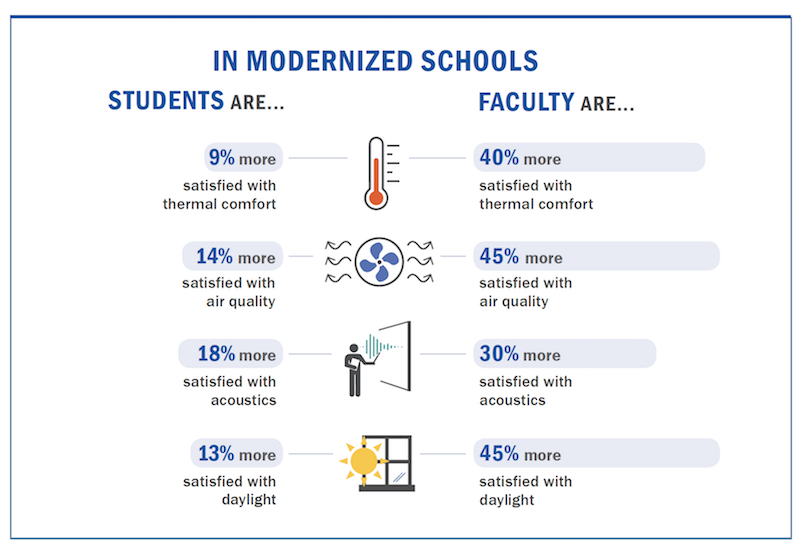It has been estimated that more than half of U.S. public schools need renovations or modernizations to be considered in good overall condition. The cost of bringing those schools up to par, though, could total nearly $200 billion.
Cash-strapped school districts that don’t have the funds to fix everything are searching for answers about where infrastructure improvements will have the greatest positive impact on students’ ability to learn and faculty’s ability to teach.
Earlier this year, Perkins Eastman partnered with the District of Columbia Public Schools on a study, cosponsored by J+J Flooring, to quantify the District’s modernization efforts. Since 2007, the District of Columbia Public Schools has invested more than $3 billion in school modernizations and improvements. Over the next six years, the District is committed to invest over $1 billion as part of its Capital Improvement Plan to modernize more school facilities.
During four consecutive weeks in February 2018, the Perkins Eastman study evaluated the level of satisfaction with Indoor Environmental Quality (IEQ)—daylight, thermal comfort, acoustics, and air quality—among occupants of nine elementary and middle public schools in the District: four that have been modernized within the last decade, and five that have had only minor improvements in the last 30 years.
The study intentionally excluded newly construction schools, and focused on younger students who are more vulnerable to environmental impacts because of their continued physical development and elevated respiratory rates.
Based on responses from four separate occupant questionnaires (whose response rate was 62% for students, 76% for faculty); on-site IEQ data collection using sensors, and school archival data on social influences, the paper reports that, in almost all IEQ factors, modernized schools saw improvements in both measured conditions and occupants’ satisfaction over non-modernized schools.

Perkins Eastman questioned students from Kindergarten to through 8th Grade, as well as faculty, and found significantly higher satisfaction levels with indoor environmental quality in modernized schools. Image: Perkins Eastman

Not surprisingly, daylight figures prominently on occupants’ satisfaction ratings. Various past surveys have found that students in classrooms with windows perform 20% faster on math tests and 26% faster on reading tests than students in windowless classroom.
For the Perkins Eastman study, two measures of daylight quality were examined in each room in both the morning and the afternoon: First, how well the daylight gets distributed throughout the entire classroom was studied using a light meter; and, second, the presence of glare or overlit conditions within classrooms was analyzed using calibrated cameras.
The results showed that the evaluated schools were generally more likely to be underlit (35%) than overlit (5%). However, schools across the study were well lit on average, with about 60% of the studied floor area meeting but not exceeding the LEED requirements for daylight autonomy and glare. The evaluated modernized schools were found to have marginally more well-lit areas than non-modernized schools
To evaluate the impact of acoustics, the study used a decibel meter to measure ambient noise levels over time. Readings showed that sound levels were 11% lower in modernized schools than in non-modernized ones. These readings likely indicate that modernizations lead to lower background noise levels due to improvements made to the mechanical systems and the building envelope to prevent infiltration of exterior noise.
However, when studying noise levels in occupied classrooms, the results showed high levels in all schools studied, regardless of whether they were recently modernized or not. These data reflect the dissatisfaction in the questionnaire responses that was found across the board with acoustics, and might indicate an issue that needs to be better addressed in modernization projects.

The amount of light in classrooms has a measurable impact on occupants' perceptions of their environment and ability to learn. Image: Perkins Eastman
To assess air quality, the study used a CO2 sensor to measure the effectiveness of ventilation. In the modernized schools, the results indicate that the median CO2 levels when occupied were 25% lower than in non-modernized schools.
The data show that modernized schools, on average, hit peak CO2 levels that were 41% lower than peak levels found in the non-modernized schools. This finding further reinforces the fact that modernized schools have improvements in ventilation effectiveness within classrooms, leading to better air quality for both students and teachers.
Lastly, this study used sensors and thermal cameras to track two aspects impacting thermal comfort: temperature of the classroom environments and thermal bridging of the building envelope. Temperatures within the evaluated modernized schools fell within ASHRAE’s comfort zone range of 68 to 75 degrees F 84% of the time. Non-modernized school fell within that range only 42% of the time
The peak temperatures of modernized schools were 4 degrees F lower than non-modernized schools, which the study found were overheated during winter months, peaking at 81 degrees F. “The non-modernized buildings may have less ability to control or deliver the appropriate amount of heat to an individual classroom space, resulting in overheating during the winter,” the paper suggests.
Related Stories
| Aug 11, 2010
Gensler, HOK, HDR among the nation's leading reconstruction design firms, according to BD+C's Giants 300 report
A ranking of the Top 100 Reconstruction Design Firms based on Building Design+Construction's 2009 Giants 300 survey. For more Giants 300 rankings, visit http://www.BDCnetwork.com/Giants
| Aug 11, 2010
Gensler among eight teams named finalists in 'classroom of the future' design competition
Eight teams were recognized today as finalists of the 2009 Open Architecture Challenge: Classroom. Finalists submitted designs ranging from an outdoor classroom for children in inner-city Chicago, learning spaces for the children of salt pan workers in India, safe spaces for youth in Bogota, Colombia and a bamboo classroom in the Himalayan mountains.
| Aug 11, 2010
ASHRAE introduces building energy label prototype
Most of us know the fuel efficiency of our cars, but what about our buildings? ASHRAE is working to change that, moving one step closer today to introducing its building energy labeling program with release of a prototype label at its 2009 Annual Conference in Louisville, Ky.
| Aug 11, 2010
10 tips for mitigating influenza in buildings
Adopting simple, common-sense measures and proper maintenance protocols can help mitigate the spread of influenza in buildings. In addition, there are system upgrades that can be performed to further mitigate risks. Trane Commercial Systems offers 10 tips to consider during the cold and flu season.
| Aug 11, 2010
Jacobs, HOK top BD+C's ranking of the 75 largest state/local government design firms
A ranking of the Top 75 State/Local Government Design Firms based on Building Design+Construction's 2009 Giants 300 survey. For more Giants 300 rankings, visit http://www.BDCnetwork.com/Giants
| Aug 11, 2010
Suffolk breaks ground on colorful charter school in Boston
Suffolk Education has broken ground and began renovations and construction of a new $39.6 million facility to house the Boston Renaissance Charter Public School. The Suffolk team is renovating an existing, three-story mill building and warehouse in the Hyde Park section of Boston, Massachusetts, and constructing a 20,000 square-foot addition.
| Aug 11, 2010
PBK, DLR Group among nation's largest K-12 school design firms, according to BD+C's Giants 300 report
A ranking of the Top 75 K-12 School Design Firms based on Building Design+Construction's 2009 Giants 300 survey. For more Giants 300 rankings, visit http://www.BDCnetwork.com/Giants
| Aug 11, 2010
Turner Building Cost Index dips nearly 4% in second quarter 2009
Turner Construction Company announced that the second quarter 2009 Turner Building Cost Index, which measures nonresidential building construction costs in the U.S., has decreased 3.35% from the first quarter 2009 and is 8.92% lower than its peak in the second quarter of 2008. The Turner Building Cost Index number for second quarter 2009 is 837.







